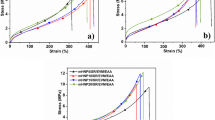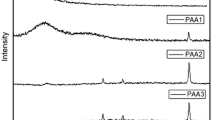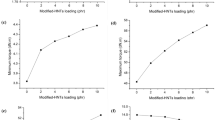Abstract
The viscoelastic properties of semi-conductive UV cured urethane acrylate/silicon carbide nanocomposites (UV-PUA/SiC) containing 0.1, 0.3, 0.6, 1, 3, and 5% (wt) of SiC are studied. Scanning electron microscopy (SEM) was employed to examine the state of the spatial distribution of SiC particles in the matrix. In conjunction with the electron microscopy technique, dynamic mechanical thermal analysis (DMTA) was employed as an indirect tool for the microstructure characterization and evaluation of the network heterogeneity and cross-link density of the nanocomposites. The influence of SiC nanoparticles on the storage modulus, loss modulus, cross-link density, glass transition temperature, and activation energy for glass transition of the UV-PUA matrix are investigated. The effect of SiC content on the network structures and degree of curing of the nanocomposites was evaluated by William-Landel-Ferry (WLF) constants. The breadth of the glass transition in the tanδ curve and shape parameter (β) in the Kolrausch-Williams-Watts (KWW) equation were used to investigate the network heterogeneity of the samples. All these referred parameters increased with SiC nanoparticles loading up to 0.6% (wt). In contrast, upon introducing SiC at higher concentrations, the viscoelastic properties of the nanocomposites reduced significantly. SEM analysis was used to evaluate the DMTA results regarding the dispersion state of the nanoparticles in the matrix.








Similar content being viewed by others
References
Bhattacharya SN, Kamal MR, Gupta RK (2008) Polymeric nanocomposites: theory and practice, Carl Hanser
Ghanbari A, Prud'homme RE (2017) Lamellar and spherulitic crystallization of poly(s-2-hydroxybutanoic acid) and its stereocomplexes. Polymer 112:377–384
Xu XF, Ghanbari A, Leelapornpisit W, Heuzey MC, Carreau P (2011) Effect of ionomer on barrier and mechanical properties of PET/organoclay nanocomposites prepared by melt compounding. Int Polym Proc 26:444–455
Ghanbari A, Behzadfar E, Arjmand M (2019) Properties of talc filled reactor-made thermoplastic polyolefin composites. J Polym Res 26:241
Ghanbari A, Heuzey M-C, Carreau PJ, Ton-That M-T (2013) Morphology and properties of polymer/organoclay nanocomposites based on poly(ethylene terephthalate) and sulfopolyester blends. Polym Int 62:439–448
Li JH, Hong RY, Li MY, Li HZ, Zheng Y, Ding J (2009) Effects of ZnO nanoparticles on the mechanical and antibacterial properties of polyurethane coatings. Prog Org Coat 64:504–509
Chisholm N, Mahfuz H, Rangari V, Adnan A, Jeelani S (2005) Fabrication and mechanical characterization of carbon/SiC-epoxy nanocomposites. Compos Struct 67:115–124
Wang K, Chen L, Wu J, Toh ML, He C, Yee AF (2005) Epoxy nanocomposites with highly exfoliated clay: mechanical properties and fracture mechanisms. Macromolecules 38:788–800
Martin JS, Laza JM, Morrás ML, Rodrı́guez M, León LM (2000) Study of the curing process of a vinyl ester resin by means of TSR and DMTA. Polymer 41:4203–4211
Gojny FH, Schulte K (2004) Functionalisation effect on the thermo-mechanical behaviour of multi-wall carbon nanotube/epoxy-composites. Compos Sci Technol 64:2303–2308
Montazeri A, Montazeri N (2011) Viscoelastic and mechanical properties of multi walled carbon nanotube/epoxy composites with different nanotube content. Mater Design 32:2301–2307
Ghanbari A, Heuzey M-C, Carreau PJ, Ton-That M-T (2013) Morphological and rheological properties of PET/clay nanocomposites. Rheol Acta 52:59–74
Shibayama K, Suzuki Y (1965) Effect of crosslinking density on the viscoelastic properties of unsaturated polyesters. J Polym Sci Part A: General Papers 3:2637–2651
Tcharkhtchi A, Lucas AS, Trotignon JP, Verdu J (1998) Viscoelastic properties of epoxy networks in the glass transition region. Polymer 39:1233–1235
Cook WD, Forsythe JS, Irawati N, Scott TF, Xia WZ (2003) Cure kinetics and thermomechanical properties of thermally stable photopolymerized dimethacrylates. J Appl Polym Sci 90:3753–3766
Cook WD, Scott TF, Quay-Thevenon S, Forsythe JS (2004) Dynamic mechanical thermal analysis of thermally stable and thermally reactive network polymers. J Appl Polym Sci 93:1348–1359
Kannurpatti AR, Anderson KJ, Anseth JW, Bowman CN (1997) Use of “living” radical polymerizations to study the structural evolution and properties of highly crosslinked polymer networks. J Polym Sci Part B: Polym Phys 35:2297–2307
Zabihi O, Khodabandeh A, Mostafavi SM (2012) Preparation, optimization and thermal characterization of a novel conductive thermoset nanocomposite containing polythiophene nanoparticles using dynamic thermal analysis. Polym Degrad Stabil 97:3–13
Mishra RS, Mishra AK, Raju KVSN (2009) Synthesis and property study of UV-curable hyperbranched polyurethane acrylate/ZnO hybrid coatings. Eur Polym J 45:960–966
Yuan Y, Shi W (2010) Preparation and properties of exfoliated nanocomposites through intercalated a photoinitiator into LDH interlayer used for UV curing coatings. Prog Org Coat 69:92–99
Scott TF, Cook WD, Forsythe JS (2008) Effect of the degree of cure on the viscoelastic properties of vinyl ester resins. Eur Polym J 44:3200–3212
Menard K (1999) Dynamic mechanical analysis. vol 9. United State of America
Jeziórska R, Sewierz-Motysia B, Szadkowska A, Marciniec B, Maciejewski H, Dutkiewicz M, Leszczyńska I (2011) Effect of POSS on morphology, thermal and mechanical properties of polyamide 6. Polimery 56:809–816
Jones DS, Tian Y, Abu-Diak O, Andrews GP (2012) Pharmaceutical applications of dynamic mechanical thermal analysis. Adv Drug Deliv Rev 64:440–448
Montazeri A, Khavandi A, Javadpour J, Tcharkhtchi A (2010) The effect of curing cycle on the mechanical properties of MWNT/epoxy nanocomposite. Int J Polym Anal Charact 15:182–190
Seyhan AT, Gojny FH, Tanoğlu M, Schulte K (2007) Rheological and dynamic-mechanical behavior of carbon nanotube/vinyl ester–polyester suspensions and their nanocomposites. Eur Polym J 43:2836–2847
O’Brien DJ, Sottos NR, White SR (2007) Cure-dependent viscoelastic Poisson’s ratio of epoxy. Exp Mech 47:237–249
Williams M, Landel R, Ferry J (1955) The temperature dependence of relaxation mechanisms in amorphous polymers and other glass-forming liquids. J Am Chem Soc 77:3701–3707
Kannurpatti AR, Anseth JW, Bowman CN (1998) A study of the evolution of mechanical properties and structural heterogeneity of polymer networks formed by photopolymerizations of multifunctional (meth)acrylates. Polymer 39:2507–2513
Zamani Ketek Lahijania Y, Mohseni M, Bastani S (2014) Characterization of mechanical behavior of UV cured urethane acrylate nanocomposite films loaded with silane treated nanosilica by the aid of nanoindentation and nanoscratch experiments. Tribol Int 69:10–18
Wang X, Xing W, Song L, Yu B, Hu Y, Yeoh GH (2013) Preparation of UV-curable functionalized graphene/polyurethane acrylate nanocomposite with enhanced thermal and mechanical behaviors. React Funct Polym 73:854–858
Madhi A, Shirkavand Hadavand B (2020) Bio-based UV-curable urethane acrylate graphene nanocomposites: synthesis and properties. SN Appl Sci 2:724
Uhl FM, Davuluri SP, Wong S-C, Webster DC (2004) Organically modified montmorillonites in UV curable urethane acrylate films. Polymer 45:6175–6187
Hadavand BS, Najafi F, Saeb MR, Malekian A (2017) Hyperbranched polyesters urethane acrylate resin: a study on synthesis parameters and viscoelastic properties. High Perform Polym 29:651–662
Shirkavand Hadavand B, Hosseini H (2016) Investigation of viscoelastic properties and thermal behavior of photocurable epoxy acrylate nanocomposites. Sci Eng Compos Mater 24
Najafi F, Shirkavand Hadavand B, Pournamdar A (2017) Trimethoxysilane-assisted UV-curable urethane acrylate as clear coating: from synthesis to properties. Colloid Polym Sci 295:1717–1728
Madhi A, Shirkavand Hadavand B, Amoozadeh A (2018) UV-curable urethane acrylate zirconium oxide nanocomposites: synthesis, study on viscoelastic properties and thermal behavior. J Compos Mater 52:002199831875617
Cheng X-E, Liu S, Shi W (2009) Synthesis and properties of silsesquioxane-based hybrid urethane acrylate applied to UV-curable flame-retardant coatings. Prog Org Coat 65:1–9
Montazeri A, Khavandi A, Javadpour J, Tcharkhtchi A (2010) Viscoelastic properties of multi-walled carbon nanotube/epoxy composites using two different curing cycles. Mater Des 31:3383–3388
Phewphong P, Saeoui P, Sirisinha C (2008) The use of dynamic mechanical thermal analysis technique for determining an uneven distribution of precipitated silica in CPE/NR blends. Polym Test 27:873–880
Pourhossaini M-R, Razzaghi-Kashani M (2014) Effect of silica particle size on chain dynamics and frictional properties of styrene butadiene rubber nano and micro composites. Polymer 55:2279–2284
Montazeri A, Pourshamsian K, Riazian M (2012) Viscoelastic properties and determination of free volume fraction of multi-walled carbon nanotube/epoxy composite using dynamic mechanical thermal analysis. Mater Des 36:408–414
Acknowledgements
The authors wish to acknowledge the assistance of the Institute for Color Science and Technology for financial support of this work.
Author information
Authors and Affiliations
Corresponding author
Electronic supplementary material
Below is the link to the electronic supplementary material.
13726_2020_871_MOESM1_ESM.doc
\(\mathrm{ln}f\) versus \(\frac{1000}{{T_{g} }}\) for nanocomposites containing a 0, b 0.6, c 1, and d 3% (wt) SiC (DOC 126 kb)
Rights and permissions
About this article
Cite this article
Ghanbari, D., Shirkavand Hadavand, B. & Pishvaei, M. Morphology and viscoelastic properties of UV cured-polyurethane acrylate/silicon carbide nanocomposites. Iran Polym J 30, 35–45 (2021). https://doi.org/10.1007/s13726-020-00871-z
Received:
Accepted:
Published:
Issue Date:
DOI: https://doi.org/10.1007/s13726-020-00871-z




